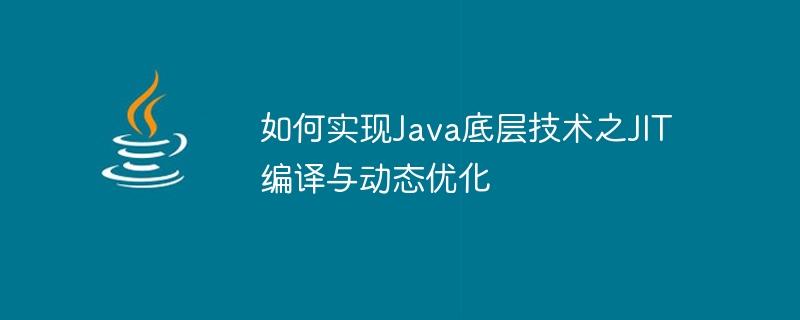

Java is one of the most popular high-level programming languages today. Because of its cross-platform nature and concise and easy-to-read code, it is widely used in website back-end development, Android mobile phone development, etc. field. The Java Virtual Machine (JVM) plays a vital role as the environment in which Java programs run. One of the most important components of the JVM is the JIT compiler, which can compile Java bytecode into local machine code to improve the execution efficiency of Java programs. This article will introduce the JIT compiler and its technology to achieve dynamic optimization in detail, and give specific code examples.
1. Principle of JIT compiler
When a Java program is executed, the source code first needs to be converted into Java bytecode. The JVM is responsible for loading Java bytecode, interpreting and executing it, and performing just-in-time compilation (JIT). Just-in-time compilation means that the JIT compiler converts Java bytecode into local machine code to further optimize execution efficiency. The JIT compiler performs a kind of dynamic compilation, that is, the compiler does not convert all the programs into machine code before the program is executed. Instead, it monitors the performance of the code while the program is running. According to the rules of performance optimization, the compiler performs dynamic compilation. The called function/code block is optimized and compiled, and the local machine code can be directly called later, thereby reducing the execution time of the program.
However, the overhead of the JIT compiler cannot be ignored. During the startup phase of the program, the JIT compiler needs to analyze the hot spots when the program is running and generate machine code for the code blocks that need to be optimized. This has a large overhead and will affect the startup speed of the program. In addition, the JIT compiler also needs to consume a certain amount of memory space to store the compiled machine code.
2. How does the JIT compiler implement dynamic optimization
Although the JIT compiler uses dynamic compilation technology to improve the execution efficiency of Java programs, it needs to solve the following two problems during its implementation:
1. When to compile the code: The code should be compiled as late as possible, because when the code to be optimized is not executed enough, the compiled code will take more time than the interpretation and execution. However, since the compiler requires an initialization process when starting up, this stage may have a greater impact on program startup time than compilation time. Therefore, in the JVM, the JIT compiler uses a "threshold" trigger method to select the code that needs to be compiled, that is, it is compiled only after a certain code block has been executed a certain number of times.
2. How to perform compilation optimization: The optimization and compilation process must be more accurate, because wrong optimization may cause the program to crash or execute abnormally. In order to achieve the best optimization effect, you need to understand the working principle of the program, the location of the bottlenecks during operation, and the optimization method. The JIT compiler contains various optimization rules, such as constant folding, code removal and optimization, and code rearrangement. These rules use runtime information within the virtual machine, such as statistics on the branch frequency and loop count of the program, to improve program performance.
A specific code example is given below:
1. Define a MyMath class:
public class MyMath {
public static int max(int a, int b) {
return a > b ? a : b;
}}
2. Define a test class TestJIT and call the max method in the MyMath class.
public class TestJIT {
public static void main(String[] args) {
long start = System.currentTimeMillis();
for(int i = 0; i < 100000000; i++) {
MyMath.max(i, i + 1);
}
long end = System.currentTimeMillis();
System.out.println("执行时间:" + (end - start));
}}
For the above code, the JIT compiler will automatically execute the MyMath.max method based on the popularity of the code and the number of executions after the code is executed. Optimize compilation to improve program execution efficiency. You can use the following JVM parameters to view the optimization effect of the JIT compiler: -XX: PrintCompilation.
Through the above code examples, we can understand how the JIT compiler works and how to achieve dynamic optimization. The JIT compiler plays a vital role in the performance and execution efficiency of Java programs, but in practical applications it is also necessary to weigh the startup time and compilation time and adopt appropriate optimization methods to improve the execution efficiency of the program.
The above is the detailed content of How to implement JIT compilation and dynamic optimization of Java underlying technology. For more information, please follow other related articles on the PHP Chinese website!
